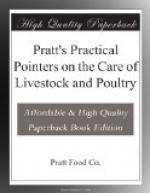(1) The amount should be determined by the observed capacity of the calf to take milk and by the relative cost of the skim-milk and the adjuncts fed along with it.
(2) During the first weeks until it begins to eat other food freely, it should be given all the milk that it will take without disturbing the digestion.
(3) Usually it would be safe to begin with six pounds of milk per day, giving eight pounds at the end of the first week, and to add one pound each week subsequently until the age of 10 to 12 weeks. Any excess of milk given at one time usually disturbs the digestion and is followed by too lax a condition of the bowels.
When milk has been the chief food, and the weaning is sudden, usually growth will be more or less arrested. When sustained largely on other foods, the change may be made without any check to the growth, even in the case of calves that suck their dams. When hand raised, the quantity of milk is gradually reduced until none is given. In the case of sucking calves they should be allowed to take milk once a day for a time before being shut entirely away from the dams. The supplementary food should be strengthened as the milk is withheld.
Calves should have constant access to good water, even during the milk period, and also to salt.
Where many are fed simultaneously, the milk should be given in pails kept scrupulously clean. The pails should be set in a manger, but not until the calves have been secured by the neck in suitable stanchions. As soon as they have taken the milk, a little meal should be thrown into each pail. Eating the dry meal takes away the desire to suck one another.
Calves of the dairy, dual purpose, and beef breeds may be reared by hand along the same lines, but with the following points of difference:
(1) The dual types want to carry more flesh than the dairy types, and the beef types more than either.
(2) To secure this end, more and richer milk must be given to calves of the beef type, especially during the first weeks of growth. Forcing calves of the beef type would be against the highest development attainable. Until the milking period is reached, the food and general treatment for the three classes is the same. They should be in fair flesh until they begin to furnish milk.
-------------------------------------------------------
---------- Coshocton, Ohio.
With good care and Pratts
Animal Regulator (which I have used for
two years) this Jersey
calf grew like a weed. I can prove what it
has done for my cow
and calves.
MRS. ELLEN BUTZ._ ------------------------------------------------------------
-----
When calves come in the autumn, the heifers enter the first winter strong and vigorous. They should be so fed that growth will be continuous right through the winter, but on cheap foods. It is different with animals for the block, which should have grain




